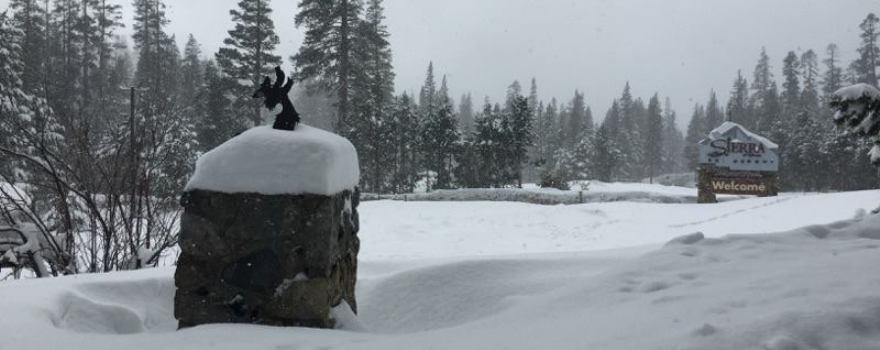
From the Department of Water Resources:
The forecasts are posted at:
WSI: http://cdec.water.ca.gov/cgi-progs/iodir/wsi
B120: http://cdec.water.ca.gov/cgi-progs/iodir?s=b120
Forecast Summary:
The projected median April-July runoff in the major Sierra river basins ranges from 75 percent on the Kern River to 115 percent on the Mokelumne River. Forecasted median water year runoff in the Sierra ranges from 68 percent on the Tule River to 104 percent on the Mokelumne River.
The WSI forecast is based on precipitation and flows observed through January 2016 and can be summarized as follows:
Sacramento River Unimpaired Runoff Water Year Forecast (50 percent exceedance)
16.3 MAF (89 percent of average)
Sacramento Valley Index (SVI) (50 percent exceedance)
6.5 (Dry)
San Joaquin Valley Index (75 percent exceedance)
2.4 (Dry)
Runoff:
The noteworthy flow pattern for January is that the Sacramento River basin flowed at a rate nearly 130 percent of average while the San Joaquin and Tulare Lake basins flowed at rates much less, 83 and 62 percent of average, respectively.
Since October 1, the flows in all regions have been below average. This should not be interpreted as an indicator of a less than average April-July runoff; snowpack is at or above normal in the Sacramento, San Joaquin Valley, and Tulare Lake regions.
Unimpaired flows for the 2015-2016 water year:
Region October-January Runoff (%) January Runoff (%) Sacramento Valley Index (4 rivers) 87 128 San Joaquin Valley Index (6 rivers) 78 83 Tulare Lake Basin (4 rivers) 55 62 Precipitation:
Precipitation for the 2015-2016 water year accumulated at the following rates of average:
Region/Index WY accumulated precipitation (%) through January 31, 2016 Sacramento River 117 San Joaquin River 136 Tulare Lake 142 Statewide 120 Northern Sierra 8-Station Index 123 (32.8 inches) San Joaquin 5-Station Index 125 (25.7 inches) Tulare Basin 6-Station Index 129 (18.5 inches) Snowpack:
Snowpack is monitored using two complementary methods: automatic snow sensor (or “pillow”) readings and manual snow course measurements. The snow sensors give us a daily snapshot of snow conditions while the manual snow course measurements provide a monthly verification of snow conditions in locations where snow has been measured in the same manner as far back as 100 years.
The results of the February 2016 statewide snow surveys are as follows:
Region No. Courses Measured
Avg WC % Average
April 1% Average
February 1North Coast 12 25.8″ 87% 140% Sacramento 71 22.0″ 77% 120% San Joaquin Valley 66 23.2″ 75% 120% Tulare Lake 40 14.3″ 61% 100% North Lahontan 12 15.0″ 72% 115% South Lahontan 17 12.1″ 52% 82% Statewide Average (weighted) 74% 117% On February 1, the snow sensor network showed similar numbers to the February snow survey results. However, dry conditions have prevailed since then resulting in the slight drop in the regional and statewide percent of averages as shown by today’s readings from the snow sensors.
The snowpack as of the morning of February 8, 2016 stands at the following (based on snow sensors):
Region Snow Water Equivalent (inches) % of Average (Apr 1) % of Average (Feb 8) Northern 23.1 79 111 Central 21.5 74 106 Southern 16.9 65 98 Statewide 20.6 73 105 Weather and Climate Outlooks:
The 6-day weather forecast indicates no precipitation. Freezing levels over the Sierra are expected to be at their highest today near 13,000 feet and will drop over the next six days to 10,000 feet.
The NWS Climate Prediction Center (CPC) one-month outlook for February, issued January 31, indicates increased chances of above normal precipitation statewide with the exception along the California-Oregon border which indicates equal chances of above or below normal precipitation. The same outlook predicts increased chances of above normal temperatures statewide with the exception along the California-Arizona border which indicates equal chances of above or below normal temperatures.
The CPC three-month (February-March-April) outlook, issued January 21, indicates increased chances of above normal precipitation statewide. The same outlook predicts increased chances of above normal temperatures statewide with the exception along the California-Arizona border which indicates equal chances of above or below normal temperatures.
El Niño conditions are present. Positive equatorial seat surface temperature (SST) anomalies continue across most of the Pacific Ocean. A strong El Niño is expected to gradually weaken through spring 2016, and to transition to ENSO-neutral during late spring or early summer 2016.
Next Update:
A Bulletin 120 update for conditions as of February 9 will be available, Thursday, February 11. The March 1, 2016 Bulletin 120 and Water Supply Index forecasts will be available on Tuesday, March 8, 2016. If you have any questions regarding this forecast, please contact a member of the Snow Surveys staff.
Important Links:
Full Natural Flow Data:
Daily FNF: http://cdec.water.ca.gov/cgi-progs/snowsurvey_ro/FNF
Monthly FNF: http://cdec.water.ca.gov/cgi-progs/snowsurvey_ro/FNFSUM
Seasonal FNF: http://cdec.water.ca.gov/cgi-progs/snowsurvey_ro/FLOWOUT
Precipitation Data:
Latest Northern Sierra 8-Station Precipitation Index: http://cdec.water.ca.gov/cgi-progs/queryDaily?s=8SI&d=today
Latest San Joaquin 5-Station Precipitation Index: http://cdec.water.ca.gov/cgi-progs/queryDaily?s=5SI&d=today
Snow Data:
Latest Snow Sensor Report: http://cdec.water.ca.gov/cgi-progs/snow/PAGE6
Latest Statewide Summary of Snow Water Equivalents: http://cdec.water.ca.gov/cgi-progs/snow/DLYSWEQ
Extended Regional Forecasts:
California Nevada River Forecast Center 6 Day QPF and Snow Level Forecast: http://www.cnrfc.noaa.gov/awipsProducts/RNOHD6RSA.php
Climate Prediction Center One-Month Outlook Forecasts: http://www.cpc.noaa.gov/products/predictions/30day/
Climate Prediction Center Three-Month Outlook Forecasts: http://www.cpc.noaa.gov/products/predictions/long_range/seasonal.php?lead=1
U.S. Seasonal Drought Outlook: http://www.cpc.ncep.noaa.gov/products/expert_assessment/sdo_summary.html
Weather Forecast Office California Service Area-Products: http://www.cnrfc.noaa.gov/forecasts.php
El Niño Southern Oscillation (ENSO) Conditions and Weekly Discussion (including La Niña): http://www.cpc.ncep.noaa.gov/products/analysis_monitoring/lanina/enso_evolution-status-fcsts-web.pdf
 Sign up for daily email service and you’ll never miss a post!
Sign up for daily email service and you’ll never miss a post!
Sign up for daily emails and get all the Notebook’s aggregated and original water news content delivered to your email box by 9AM. Breaking news alerts, too. Sign me up!

